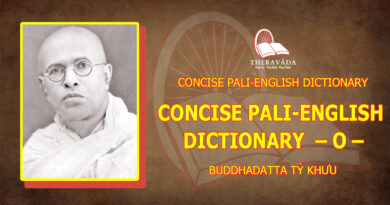BEGINNINGS: THE PALI SUTTAS – PART II: SYNCRETISM
Syncretism?
It may be objected at this point (or even sooner) that all this inquiry is absurd and that the “obvious” approach, for goodness sake, is to take whatever is useful wherever we find it and to get on with the thing already instead of dancing about the starting line for, after all, truth isn’t the exclusive preserve of any one narrow sectarian doctrine, is it? And this eclectic attitude sounds very good until one tries to “get on with the thing” by taking “whatever is useful” etc., for it is at precisely this point — the point of beginning — that the question arises: what is useful? And what merely seems to our blind eyes to be so? Without a standard we would be unable to choose between meditation, ascetic austerities, or prayers to the heavens as paths to liberation. It is precisely this — a standard — that we felt ourselves to be in need of when we decided to seek guidance beyond our personal opinions and judgements.
Although the question of specific doctrines lies outside our present inquiry (for we are not yet well-placed to make the necessary distinctions), something can nevertheless be said about the approach to specific doctrines, i.e. making a beginning. Here the question is not “Where does one begin?” but “How does one begin?”: perhaps the question that immediately follows upon “where?” and which is still prior to any actual beginning. And there seem to be two general answers to this question, How does one begin?, which we can conveniently label as the “syncretistic” approach and the “crystalline” approach.
In the syncretistic approach one views spiritual teachings as if they were a smorgasboard spread out on an enormous table, to be partaken of by all who seek spiritual sustenance. The seeker, plate in hand, helps himself to whatever he cares to, in whatever quantity and variety appeals to him — let’s see now, a bit of TM on toast, some Karma Yoga and cole slaw, a dash of Sufism for spice, a bit of this, a bit of that — and if he has chosen wisely, he will consume, spiritually, a satisfying and nutritious blend which — who knows — just might lead to….
The crystalline approach, on the other hand, assumes that no truth can be more consistent or relevant than the teaching by which it is revealed, and that therefore a teaching that truly leads — i.e. is one-pointed and consistent rather than an amorphous collection of spiritualisms — is akin to a many-faceted crystal, wherein each facet may reflect its own prismatic colours, but each is nonetheless inseparable from the crystal as a whole, for the crystal, being an organic unity, is indivisible. In this approach there can be no pick-and-choose attitude, for to fragment such a teaching is to miss its holistic essence. In such a case, having once made the decision that this is the standard we choose to follow, we will thereupon voluntarily subjugate our personal preferences in favour of the advice of our teaching, even if it is directly contrary to our own wishes. This does not preclude taking “whatever is useful”. Rather, it gives us a basis for judging what is and is not useful. And if it should happen that within our chosen teaching we already find all that we need in order to “get on with it”, then so much the better.
But if the charge of narrowness is nonetheless made, then we will note first that an arrow that is broad and wide is far less likely to hit its mark than one that is properly shaped for one-pointed flight; and second that the charge of narrowness is made without understanding. For no point of view can be understood except from its own frame of reference, an observation which already suggests the crystalline approach, for all that it is true of syncretistic views as well.[4] It is most commonly the case that people do not question the assumptions that underlie their own basic attitudes — after all, it’s obvious, isn’t it? — but until they do so, they will be necessarily unable to understand a point of view that does not arise from those assumptions except from within their own viewpoint, which is to say that they will not be able to understand it at all. And the charge of narrowness is made from the syncretistic point of view without comprehending the crystalline point of view.
The collection of discourses known as the Pali Suttas heartedly recommends itself to the concerned individual as being that guidance to the transcendental which he seeks. They inform the seeker firstly that his life-problem arises dependent for its condition upon a wrong view of things, and secondly that a right view, which would undermine and end that problem, is to be achieved by following right-view guidance, namely, the training-course set forth by the Buddha. There can be no doubt after even a brief look at these texts that they staunchly advocate the crystalline approach towards liberation. In many ways do they declare themselves to be all-of-a-piece,[5a] a Teaching not to be understood by taking from it according to personal preference.[5b] Therefore when inquiring into the Pali Suttas it is a necessity, if one hopes to understand what is meant therein by “right view”, to adopt the crystalline approach, and we do so here.









